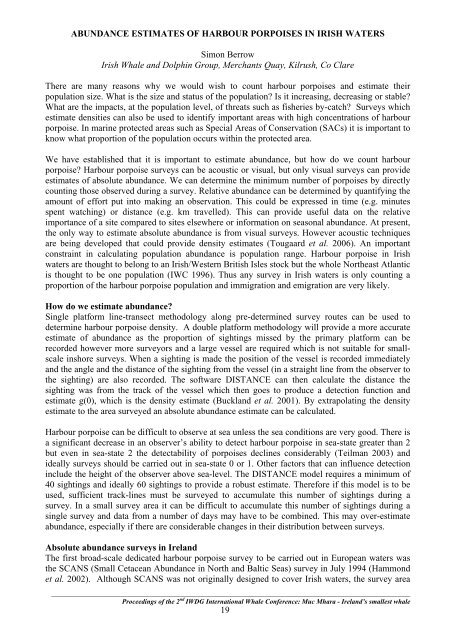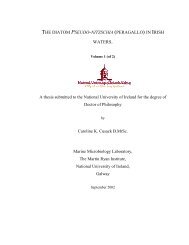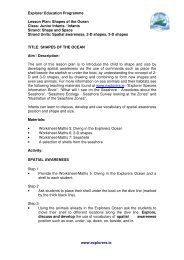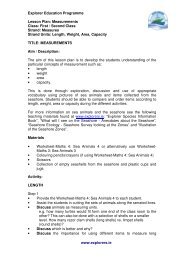Muc Mhara Ireland's Smallest Whale - Marine Institute Open Access ...
Muc Mhara Ireland's Smallest Whale - Marine Institute Open Access ...
Muc Mhara Ireland's Smallest Whale - Marine Institute Open Access ...
Create successful ePaper yourself
Turn your PDF publications into a flip-book with our unique Google optimized e-Paper software.
ABUNDANCE ESTIMATES OF HARBOUR PORPOISES IN IRISH WATERS<br />
Simon Berrow<br />
Irish <strong>Whale</strong> and Dolphin Group, Merchants Quay, Kilrush, Co Clare<br />
There are many reasons why we would wish to count harbour porpoises and estimate their<br />
population size. What is the size and status of the population? Is it increasing, decreasing or stable?<br />
What are the impacts, at the population level, of threats such as fisheries by-catch? Surveys which<br />
estimate densities can also be used to identify important areas with high concentrations of harbour<br />
porpoise. In marine protected areas such as Special Areas of Conservation (SACs) it is important to<br />
know what proportion of the population occurs within the protected area.<br />
We have established that it is important to estimate abundance, but how do we count harbour<br />
porpoise? Harbour porpoise surveys can be acoustic or visual, but only visual surveys can provide<br />
estimates of absolute abundance. We can determine the minimum number of porpoises by directly<br />
counting those observed during a survey. Relative abundance can be determined by quantifying the<br />
amount of effort put into making an observation. This could be expressed in time (e.g. minutes<br />
spent watching) or distance (e.g. km travelled). This can provide useful data on the relative<br />
importance of a site compared to sites elsewhere or information on seasonal abundance. At present,<br />
the only way to estimate absolute abundance is from visual surveys. However acoustic techniques<br />
are being developed that could provide density estimates (Tougaard et al. 2006). An important<br />
constraint in calculating population abundance is population range. Harbour porpoise in Irish<br />
waters are thought to belong to an Irish/Western British Isles stock but the whole Northeast Atlantic<br />
is thought to be one population (IWC 1996). Thus any survey in Irish waters is only counting a<br />
proportion of the harbour porpoise population and immigration and emigration are very likely.<br />
How do we estimate abundance?<br />
Single platform line-transect methodology along pre-determined survey routes can be used to<br />
determine harbour porpoise density. A double platform methodology will provide a more accurate<br />
estimate of abundance as the proportion of sightings missed by the primary platform can be<br />
recorded however more surveyors and a large vessel are required which is not suitable for smallscale<br />
inshore surveys. When a sighting is made the position of the vessel is recorded immediately<br />
and the angle and the distance of the sighting from the vessel (in a straight line from the observer to<br />
the sighting) are also recorded. The software DISTANCE can then calculate the distance the<br />
sighting was from the track of the vessel which then goes to produce a detection function and<br />
estimate g(0), which is the density estimate (Buckland et al. 2001). By extrapolating the density<br />
estimate to the area surveyed an absolute abundance estimate can be calculated.<br />
Harbour porpoise can be difficult to observe at sea unless the sea conditions are very good. There is<br />
a significant decrease in an observer’s ability to detect harbour porpoise in sea-state greater than 2<br />
but even in sea-state 2 the detectability of porpoises declines considerably (Teilman 2003) and<br />
ideally surveys should be carried out in sea-state 0 or 1. Other factors that can influence detection<br />
include the height of the observer above sea-level. The DISTANCE model requires a minimum of<br />
40 sightings and ideally 60 sightings to provide a robust estimate. Therefore if this model is to be<br />
used, sufficient track-lines must be surveyed to accumulate this number of sightings during a<br />
survey. In a small survey area it can be difficult to accumulate this number of sightings during a<br />
single survey and data from a number of days may have to be combined. This may over-estimate<br />
abundance, especially if there are considerable changes in their distribution between surveys.<br />
Absolute abundance surveys in Ireland<br />
The first broad-scale dedicated harbour porpoise survey to be carried out in European waters was<br />
the SCANS (Small Cetacean Abundance in North and Baltic Seas) survey in July 1994 (Hammond<br />
et al. 2002). Although SCANS was not originally designed to cover Irish waters, the survey area<br />
_________________________________________________________________________________________________________<br />
Proceedings of the 2 nd IWDG International <strong>Whale</strong> Conference: <strong>Muc</strong> <strong>Mhara</strong> - Ireland’s smallest whale<br />
19





